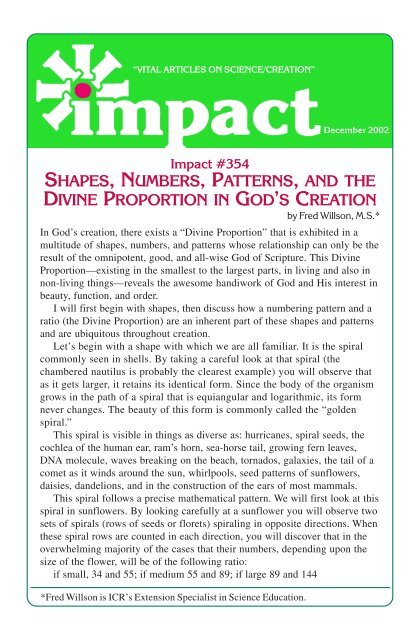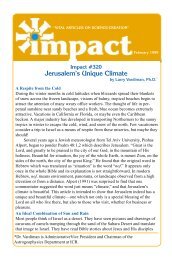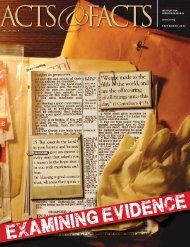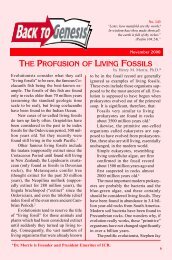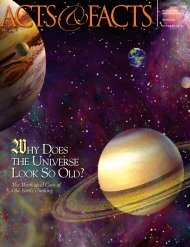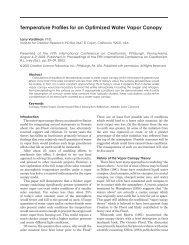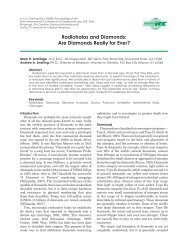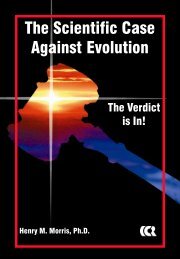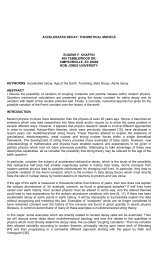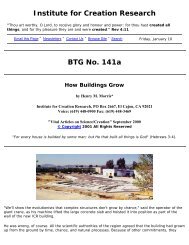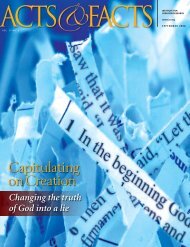shapes, numbers, patterns, and the divine proportion in god's creation
shapes, numbers, patterns, and the divine proportion in god's creation
shapes, numbers, patterns, and the divine proportion in god's creation
You also want an ePaper? Increase the reach of your titles
YUMPU automatically turns print PDFs into web optimized ePapers that Google loves.
“VITAL ARTICLES ON SCIENCE/CREATION”December 2002Impact #354SHAPES, NUMBERS, PATTERNS, AND THEDIVINE PROPORTION IN GOD’S CREATIONby Fred Willson, M.S.*In God’s <strong>creation</strong>, <strong>the</strong>re exists a “Div<strong>in</strong>e Proportion” that is exhibited <strong>in</strong> amultitude of <strong>shapes</strong>, <strong>numbers</strong>, <strong>and</strong> <strong>patterns</strong> whose relationship can only be <strong>the</strong>result of <strong>the</strong> omnipotent, good, <strong>and</strong> all-wise God of Scripture. This Div<strong>in</strong>eProportion—exist<strong>in</strong>g <strong>in</strong> <strong>the</strong> smallest to <strong>the</strong> largest parts, <strong>in</strong> liv<strong>in</strong>g <strong>and</strong> also <strong>in</strong>non-liv<strong>in</strong>g th<strong>in</strong>gs—reveals <strong>the</strong> awesome h<strong>and</strong>iwork of God <strong>and</strong> His <strong>in</strong>terest <strong>in</strong>beauty, function, <strong>and</strong> order.I will first beg<strong>in</strong> with <strong>shapes</strong>, <strong>the</strong>n discuss how a number<strong>in</strong>g pattern <strong>and</strong> aratio (<strong>the</strong> Div<strong>in</strong>e Proportion) are an <strong>in</strong>herent part of <strong>the</strong>se <strong>shapes</strong> <strong>and</strong> <strong>patterns</strong><strong>and</strong> are ubiquitous throughout <strong>creation</strong>.Let’s beg<strong>in</strong> with a shape with which we are all familiar. It is <strong>the</strong> spiralcommonly seen <strong>in</strong> shells. By tak<strong>in</strong>g a careful look at that spiral (<strong>the</strong>chambered nautilus is probably <strong>the</strong> clearest example) you will observe thatas it gets larger, it reta<strong>in</strong>s its identical form. S<strong>in</strong>ce <strong>the</strong> body of <strong>the</strong> organismgrows <strong>in</strong> <strong>the</strong> path of a spiral that is equiangular <strong>and</strong> logarithmic, its formnever changes. The beauty of this form is commonly called <strong>the</strong> “goldenspiral.”This spiral is visible <strong>in</strong> th<strong>in</strong>gs as diverse as: hurricanes, spiral seeds, <strong>the</strong>cochlea of <strong>the</strong> human ear, ram’s horn, sea-horse tail, grow<strong>in</strong>g fern leaves,DNA molecule, waves break<strong>in</strong>g on <strong>the</strong> beach, tornados, galaxies, <strong>the</strong> tail of acomet as it w<strong>in</strong>ds around <strong>the</strong> sun, whirlpools, seed <strong>patterns</strong> of sunflowers,daisies, d<strong>and</strong>elions, <strong>and</strong> <strong>in</strong> <strong>the</strong> construction of <strong>the</strong> ears of most mammals.This spiral follows a precise ma<strong>the</strong>matical pattern. We will first look at thisspiral <strong>in</strong> sunflowers. By look<strong>in</strong>g carefully at a sunflower you will observe twosets of spirals (rows of seeds or florets) spiral<strong>in</strong>g <strong>in</strong> opposite directions. When<strong>the</strong>se spiral rows are counted <strong>in</strong> each direction, you will discover that <strong>in</strong> <strong>the</strong>overwhelm<strong>in</strong>g majority of <strong>the</strong> cases that <strong>the</strong>ir <strong>numbers</strong>, depend<strong>in</strong>g upon <strong>the</strong>size of <strong>the</strong> flower, will be of <strong>the</strong> follow<strong>in</strong>g ratio:if small, 34 <strong>and</strong> 55; if medium 55 <strong>and</strong> 89; if large 89 <strong>and</strong> 144*Fred Willson is ICR’s Extension Specialist <strong>in</strong> Science Education.
These <strong>numbers</strong> are part of <strong>the</strong> Fibonacci number<strong>in</strong>g sequence, a pattern discoveredaround A.D. 1200 by Leonardo Pisa (historically known as Fibonacci). Eachsucceed<strong>in</strong>g number is <strong>the</strong> sum of <strong>the</strong> two preced<strong>in</strong>g <strong>numbers</strong>. The sequence of <strong>the</strong>se<strong>numbers</strong> is 1,2,3,5,8,13,21,34,55,89,144,233, ad <strong>in</strong>f<strong>in</strong>itum. This number<strong>in</strong>g patternreveals itself <strong>in</strong> various ways throughout all of nature, as we shall see.When <strong>the</strong> smaller number of this pattern is divided <strong>in</strong>to <strong>the</strong> larger numberadjacent to it, <strong>the</strong> ratio will be approximately 1.618; if <strong>the</strong> larger one adjacent to itdivides <strong>the</strong> smaller number, <strong>the</strong> ratio is very close to 0.618. This ratio is <strong>the</strong> mostefficient of similar series of <strong>numbers</strong>.BeautyWhy did Phideas, <strong>the</strong> Greek sculptor, <strong>and</strong> o<strong>the</strong>rs <strong>in</strong> ancient Greece <strong>and</strong> Egyptoften use this ratio <strong>in</strong> design<strong>in</strong>g many of <strong>the</strong>ir works of art? Because this ratio hasbeen found to be remarkably pleas<strong>in</strong>g to <strong>the</strong> human eye, it produces what is called aGolden Rectangle. If <strong>the</strong> short side of <strong>the</strong> rectangle is 1, <strong>the</strong> long side will be 1.618.This rectangular shape was close to <strong>the</strong> pattern used <strong>in</strong> <strong>the</strong> design<strong>in</strong>g of <strong>the</strong>Par<strong>the</strong>non of Greece <strong>and</strong> for many of <strong>the</strong>ir numerous pictures, vases, doorways,w<strong>in</strong>downs, statues, etc., <strong>and</strong> even for certa<strong>in</strong> features of <strong>the</strong> Great Pyramid of Egypt.The United Nations build<strong>in</strong>g is a golden rectangle. Many of <strong>the</strong> th<strong>in</strong>gs you use are(approximately) patterned after <strong>the</strong> golden rectangle—credit cards, play<strong>in</strong>g cards,postcards, light switch plates, writ<strong>in</strong>g pads, 3-by-5 <strong>and</strong> 5-by-8 cards, etc. 1Artists such as Leonardo da V<strong>in</strong>ci, Van Gogh, Vermeer, Sargent, Monet, Whistler,Renoir, <strong>and</strong> o<strong>the</strong>rs employed <strong>the</strong> golden <strong>proportion</strong> <strong>in</strong> many of <strong>the</strong>ir works. Theywould “take a blank easel <strong>and</strong> divide it <strong>in</strong>to areas based on <strong>the</strong> golden <strong>proportion</strong>s todeterm<strong>in</strong>e <strong>the</strong> placement of horizons, trees, <strong>and</strong> so on.” 2 Why <strong>the</strong> golden <strong>proportion</strong>?Art forms can be ei<strong>the</strong>r of static or dynamic symmetry. In static symmetry <strong>the</strong> l<strong>in</strong>eshave def<strong>in</strong>ite measurements whereas <strong>in</strong> dynamic symmetry it is <strong>the</strong> <strong>proportion</strong><strong>in</strong>g of<strong>the</strong> areas that is given emphasis. It implies “growth, power, movement. It givesanimation <strong>and</strong> life to an artist’s work . . . ra<strong>the</strong>r than <strong>the</strong> effect of stillness <strong>and</strong> quiet”3of static symmetry. This is <strong>the</strong> appeal of <strong>the</strong> golden <strong>proportion</strong>.Ano<strong>the</strong>r area of great <strong>in</strong>terest is <strong>the</strong> occurrence of Fibonacci <strong>numbers</strong> <strong>in</strong> <strong>the</strong>spiral arrangement of leaves around a plant’s stem (called phyllotaxis). This spiralpattern is observed by view<strong>in</strong>g <strong>the</strong> stem from directly above, <strong>and</strong> not<strong>in</strong>g <strong>the</strong> arc of<strong>the</strong> stem form one leaf base to <strong>the</strong> next, <strong>and</strong> <strong>the</strong> fraction of <strong>the</strong> stem circumferencewhich is <strong>in</strong>scribed. In each case <strong>the</strong> <strong>numbers</strong> are Fibonacci <strong>numbers</strong>. Examples: Inan elm <strong>the</strong> arc is 1/2 <strong>the</strong> circumference; <strong>in</strong> beech <strong>and</strong> hazel, 1/3; apricot, oak, 2/5;<strong>in</strong> pear <strong>and</strong> poplar, 3/8; <strong>in</strong> almond <strong>and</strong> pussy willow, 5/13; <strong>and</strong> <strong>in</strong> some p<strong>in</strong>esei<strong>the</strong>r 5/21 or 13/34. Why did God arrange <strong>the</strong>m this way? This pattern assuresthat each leaf will receive its maximum exposure to sunlight <strong>and</strong> air withoutshad<strong>in</strong>g or crowd<strong>in</strong>g o<strong>the</strong>r leaves.Not only do we discover this pattern <strong>in</strong> leaf arrangements, but it is alsocommonly found <strong>in</strong> <strong>the</strong> arrangement of many flower petals. Examples: a lily has3 petals, yellow violet 5, delph<strong>in</strong>ium 8, mayweed 13, aster 21, pyrethrum 34,helenium 55, <strong>and</strong> michaelmas daisy 89. With such a great variety of spiral ratios<strong>in</strong> leaf <strong>and</strong> petal arrangement, no one has any reason to get bored with God’s<strong>creation</strong>.ii
When we realize that <strong>the</strong> <strong>in</strong>formation to produce <strong>the</strong>se spirals <strong>and</strong> <strong>numbers</strong> <strong>in</strong> liv<strong>in</strong>gth<strong>in</strong>gs is stored <strong>in</strong> <strong>the</strong> DNA, should we <strong>the</strong>n be surprised to f<strong>in</strong>d that <strong>the</strong> DNA moleculeis 21 angstroms <strong>in</strong> width <strong>and</strong> <strong>the</strong> length of one full turn <strong>in</strong> its spiral is 34 angstroms, bothFibonacci <strong>numbers</strong>? The DNA molecule is literally one long stack of golden rectangles. 4Let’s look <strong>in</strong>to <strong>the</strong> area of very small <strong>and</strong> very large th<strong>in</strong>gs. In <strong>the</strong> world of atoms<strong>the</strong>re are four fundamental asymmetries (structure of atomic nuclei, distribution offission fragments, distribution of <strong>numbers</strong> of isotopes, <strong>and</strong> <strong>the</strong> distribution ofemitted particles), <strong>and</strong> it is significant that “<strong>the</strong> numerical values of all of <strong>the</strong>seasymmetries are equal approximately to <strong>the</strong> ‘golden ratio,’ <strong>and</strong> that <strong>the</strong> numberform<strong>in</strong>g <strong>the</strong>se values are sometimes Fibonacci or ‘near’ Fibonacci <strong>numbers</strong>.” 5 Inchang<strong>in</strong>g states of a quantity of hydrogen atoms, as <strong>the</strong> atoms ga<strong>in</strong> <strong>and</strong> lose radiantenergy at succeed<strong>in</strong>g energy levels, <strong>the</strong> chang<strong>in</strong>g <strong>proportion</strong> of <strong>the</strong> histories of <strong>the</strong>atomic electrons form Fibonacci <strong>numbers</strong>. 6In <strong>the</strong> area of very large phenomena when <strong>the</strong> time period of each planet’srevolution around <strong>the</strong> sun is compared <strong>in</strong> round <strong>numbers</strong> to <strong>the</strong> one adjacent to it,<strong>the</strong>ir fractions are Fibonacci <strong>numbers</strong>! Beg<strong>in</strong>n<strong>in</strong>g with Neptune 7 <strong>and</strong> mov<strong>in</strong>g <strong>in</strong>wardtoward <strong>the</strong> sun, <strong>the</strong> ratios are 1/2, 1/3, 2/5, 3/8, 5/13, 8/21, 13/34. These are <strong>the</strong> sameas <strong>the</strong> spiral arrangement of leaves on plants!Revolution of <strong>the</strong> planets <strong>in</strong> days <strong>and</strong> <strong>the</strong>ir correlation toFibonacci <strong>numbers</strong> <strong>and</strong> spiral arrangement of leaves on plants 8Observed (<strong>the</strong>oretical) Ratio Plants(Pluto) 90,000 (2:3 Neptune) —Neptune 60,193 62,000 —Uranus 30,688 31,000 1:2 ElmSaturn 10,760 10,333 1:3 BeechJupiter 4,332 4,133 2:5 ApricotAsteroids 1200-2000 1,550 3:8 PearMars 687 596 5:13 AlmondEarth 365 366 8/13 8:21 —Venus 225 277 13/21 P<strong>in</strong>eMercury 88 87 13:34 P<strong>in</strong>eThere are <strong>creation</strong>ists who have <strong>the</strong>orized that some cosmic force, probably <strong>in</strong>relation to <strong>the</strong> day of Noah’s flood, altered <strong>the</strong> solar system, especially from Venusto <strong>the</strong> asteroid belt. This may account for <strong>the</strong> only significant <strong>the</strong>oretical adjustments<strong>in</strong> <strong>the</strong> chart: Mars (687 to 596), <strong>and</strong> Venus (225 to 277); <strong>the</strong> rest are veryclose to reality. Even with <strong>the</strong>se two adjustments, <strong>the</strong> correlation of <strong>the</strong> Fibonaccipattern to <strong>the</strong> periodic times of <strong>the</strong> planets is far more than just a chance arrangement.It is one more example of God’s marvelous ma<strong>the</strong>matical arrangement of His<strong>creation</strong>. The fact that it is not perfect reveals that although Adam’s s<strong>in</strong> affected <strong>the</strong>whole <strong>creation</strong> (Romans 8:22), yet God <strong>in</strong> His goodness has not allowed s<strong>in</strong> toovercome all <strong>the</strong> marks of His great h<strong>and</strong>iwork (Psalm 19:1).A most <strong>in</strong>terest<strong>in</strong>g divergence <strong>in</strong> <strong>the</strong> chart is that of <strong>the</strong> Earth. As <strong>the</strong> next planet<strong>in</strong> <strong>the</strong> series after Mars, its number should be 8:21, but it isn’t. This number “skips”over Earth <strong>and</strong> connects to Venus. Even with this divergence we f<strong>in</strong>d that <strong>the</strong> Earth’speriod compared to Mars <strong>and</strong> Venus are Fibonacci <strong>numbers</strong> (8/13, 13/21). It is myiii
op<strong>in</strong>ion that this anomaly is evidence of God’s show<strong>in</strong>g <strong>the</strong> uniqueness of planetEarth <strong>in</strong> relationship to <strong>the</strong> whole cosmos. It also accomplishes ano<strong>the</strong>r fact, for this“anomaly” shatters <strong>the</strong> big bang <strong>and</strong> nebular hypo<strong>the</strong>sis, for if all <strong>the</strong> planets formedfrom a whirl<strong>in</strong>g cloud of dust <strong>and</strong> atoms, this feature would not be present. To th<strong>in</strong>kthat <strong>the</strong> times of revolution of <strong>the</strong> planets around <strong>the</strong> sun correlates with <strong>the</strong>arrangement of leaves around stems on plants is also an amaz<strong>in</strong>g phenomena.These <strong>shapes</strong>, <strong>numbers</strong>, spirals, <strong>and</strong> <strong>the</strong> <strong>div<strong>in</strong>e</strong> <strong>proportion</strong> are ubiquitous <strong>in</strong> <strong>the</strong>irpresence throughout all of <strong>creation</strong>. They are found <strong>in</strong> liv<strong>in</strong>g <strong>and</strong> nonliv<strong>in</strong>g phenomena.Their symmetry, beauty, <strong>and</strong> ma<strong>the</strong>matical preciseness are evident <strong>in</strong> everyaspect of nature. Although absolute perfection is not found <strong>in</strong> all of <strong>the</strong>se (due to <strong>the</strong>effects of Adam’ s<strong>in</strong>), <strong>the</strong>ir very presence virtually everywhere <strong>and</strong> <strong>in</strong> everyth<strong>in</strong>gargues aga<strong>in</strong>st <strong>the</strong>ir hav<strong>in</strong>g occurred by bl<strong>in</strong>d chance or evolutionary processes. Theonly rational conclusion is that <strong>the</strong> Creator of <strong>the</strong> universe is a personal, <strong>in</strong>telligentBe<strong>in</strong>g, who created <strong>the</strong>se th<strong>in</strong>gs as a visible f<strong>in</strong>gerpr<strong>in</strong>t of His <strong>in</strong>visible, yet personalexistence. This great, wise, powerful, creative, <strong>and</strong> sovereign God of <strong>creation</strong> is <strong>the</strong>One revealed <strong>in</strong> <strong>the</strong> Bible, of whom it can be said, “Great th<strong>in</strong>gs doeth He, whichwe cannot comprehend” (Job 37:5). He is worthy of worship. And what is Hisname? The Lord Jesus Christ. “Thou art worthy, O Lord, to receive glory <strong>and</strong>honour <strong>and</strong> power: for thou hast created all th<strong>in</strong>gs, <strong>and</strong> for thy pleasure <strong>the</strong>y are <strong>and</strong>were created” (Revelation 4:11).References1. Trudi Hammel Garl<strong>and</strong>, Fasc<strong>in</strong>at<strong>in</strong>g Fibonaccis, Dale Seymour Publications,1987, p. 19. Available: www.bbhomeschoolcatalog.com or 800/260-5461.2. Ibid., pp. 34, 36.3. Garth E. Runion, The Golden Section, Dale Seymour Publications, Palo Alto,CA. 1990, pp. 84–85.4. Marl Wahl, A Ma<strong>the</strong>matical Mystery Tour, Zephry Press, Tucson, AZ. 1988,p. 128.5. J. Wlodarski, “The Golden Ratio <strong>and</strong> <strong>the</strong> Fibonacci Numbers <strong>in</strong> <strong>the</strong> World ofAtoms,” Fibonacci Quarterly, December 1963, p. 61.6. H. E. Huntley, “Fibonacci <strong>and</strong> <strong>the</strong> Atom,” Fibonacci Quarterly, December1969, pp. 523–524.7. There is still controversy as to whe<strong>the</strong>r Pluto is a real planet. Whe<strong>the</strong>r or not itis, its distance from Neptune is still a Fibonacci ratio, even if <strong>in</strong> <strong>the</strong> oppositedirection.8. Marcius Willson, The Fourth Reader of <strong>the</strong> School <strong>and</strong> Family, Harper &Bro<strong>the</strong>rs, Publishers, New York, 1860, p. 216.iv© 2002 by ICR • All Rights ReservedS<strong>in</strong>gle Copies 10¢ • Order From: INSTITUTE FOR CREATION RESEARCHP.O. Box 2667, El Cajon, CA 92021 • Available for download on our website (www.icr.org).


